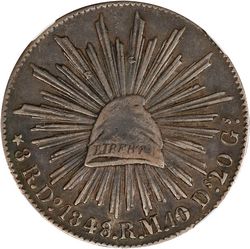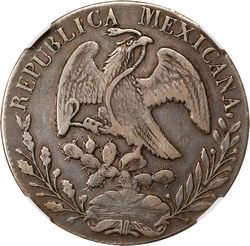Initials on 8 Reales coins of the Durango Mint: 1842, 1848 and 1849
by Clyde Hubbard
1842
[image needed]
An 8 Reales coin of 1842 Do mint, Assayer R.M., with the Mexican type eagle has a capital letter B just above the knot uniting the two elements of the wreath on the lower portion of the obverse. Clyde Hubbard suggests the letter B stands for the lessee, Bras de Fer.
1848 and 1849


KM-377.4 Durango 8R 1848/7 DoRM, hidden "B" and "G" in rays (Stack’s Bowers auction, 16 May 2023, lot 70421)

All of the 8 Reales coins of the Durango mint dated 1848 and some of the 1849 pieces have initials that were placed on them by the engraver of the dies. These exist in several combinations of B G Y, B G and Y distributed on the obverse and reverse representing the initials of the mint director, Bernardo GeorgyAn explanation of the B G Y initials is found in the first published report of the Mexican Republican mints, Memoria de Hacienda sobre Casas de Moneda de la República, Mexico, 1849. Further details appear in. Pradeau's Historia Numismática de México, vol. 2, 1960 and Dunigan and Parker’s Resplandores,.
The State of Durango leased the mint in 1829[text needed] for a period of 15 years to Manuel Bras de Fer and Jose Antonio Pescador. The lease expired on 24 November 1844 at which time the mint was closed in absence of instructions about a new lease. On 5 February 1845 the State assembly signed a temporary lease[text needed] with a German Citizen, German Stahlknecht, making him mint director.
By law of 17 November 1824[text needed], all mints came under the control of the respective states in which they were situated; however, the centralist system of government prevailing after 27 October 1835 left the states with very little liberty of action. A law of 17 September 1846[text needed] stated that coinage was an exclusive right of the national government so that mints no longer came under the control of the local governments.
On 28 October 1845 the federal monetary commission recommended that the Durango mint be operated by the government and not leased to private parties, but Hacienda authorities did not approve the idea. A request was made by Joaquin Roldan to have the mint contract put up for public auction; nevertheless, the provisional contract made with Stahlknecht was reconfirmed as of 23 July 1846[text needed]. Shortly after this it was noted that the actual director of the mint was Carlos Stahlknecht, brother of German.
It was also observed that counterfeit coins were circulating in the area of the type, diameter, thickness and having all other characteristics of the genuine coins. Some such when presented to the mint assayer for examination were pronounced genuine at first sight but were found to be spurious when subjected to analysis. The fineness was only 5 dineros 12 1/2 granos (about .460) instead of the legal 10 dineros 20 granos (about .902). The most commonly seen counterfeits are dated 1833 and were made with genuine dies of the type made in France for Durango.
After confirming that bad money was in circulation the government named an inspector, Dionisio Guerrero Tavizon, to check mint operations. When Guerrero Tavizon, began to check the foundry records Carlos Stahlknecht transferred the mint lease to Bernardo Georgy. Confrontations between Georgy and the government inspector became so disagreeable that Georgy prohibited the inspector from entering the mint premises, ordering the guard at the door to use arms if necessary to keep him out.
Too many inconsistencies and violations of the terms of the lease existed so that the contract which still had four years to run was rescinded on 6 June 1849. During the arguments and counter-arguments that preceded this action it came out that Georgy had placed his initials on coins struck during his directorship to distinguish them from the counterfeits that were circulating. This of course was in direct violation of government regulations regarding coinage.
